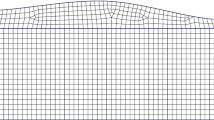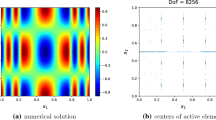Abstract
We combine the newly constructed Galerkin difference basis with the energy-based discontinuous Galerkin method for wave equations in second-order form. The approximation properties of the resulting method are excellent and the allowable time steps are large compared to traditional discontinuous Galerkin methods. The one drawback of the combined approach is the cost of inversion of the local mass matrix. We demonstrate that for constant coefficient problems on Cartesian meshes this bottleneck can be removed by the use of a modified Galerkin difference basis. For variable coefficients or non-Cartesian meshes this technique is not possible and we instead use the preconditioned conjugate gradient method to iteratively invert the mass matrices. With a careful choice of preconditioner we can demonstrate optimal complexity, albeit with a larger constant.











Similar content being viewed by others
References
Ainsworth, M.: Dispersive and dissipative behaviour of high order discontinuous Galerkin finite element methods. J. Comput. Phys. 198(1), 106–130 (2004)
Ainsworth, M., Monk, P., Muniz, W.: Dispersive and dissipative properties of discontinuous Galerkin finite element methods for the second-order wave equation. J. Sci. Comput. 27, 5–40 (2006)
Appelö, D., Hagstrom, T.: A new discontinuous Galerkin formulation for wave equations in second order form. SIAM J. Numer. Anal. 53(6), 2705–2726 (2015)
Appelö, D., Hagstrom, T.: An energy-based discontinuous Galerkin discretization of the elastic wave equation in second order form. Comput. Methods Appl. Mech. Eng. 338, 362–391 (2018)
Appelö, D., Hagstrom, T., Wang, Q., Zhang, L.: An energy-based discontinuous Galerkin method for semilinear wave equations. J. Comput. Phys. 418, 109608 (2020)
Banks, J.W., Buckner, B.B., Hagstrom, T., Juhnke, K.: Discontinuous Galerkin Galerkin differences for the wave equation in second-order form. SIAM J. Sci. Comput. 43(2), A1497–A1526 (2021)
Banks, J.W., Hagstrom, T.: On Galerkin difference methods. J. Comput. Phys. 313, 310–327 (2016)
Banks, J.W., Henshaw, W.D.: Upwind schemes for the wave equation in second-order form. J. Comput. Phys. 231(17), 5854–5889 (2012). https://doi.org/10.1016/j.jcp.2012.05.012. http://www.sciencedirect.com/science/article/pii/S0021999112002367
Chan, J., Hewett, R.J., Warburton, T.: Weight-adjusted discontinuous Galerkin methods: curvilinear meshes. SIAM J. Sci. Comput. 39(6), A2395–A2421 (2017)
Chan, J., Hewett, R.J., Warburton, T.: Weight-adjusted discontinuous Galerkin methods: wave propagation in heterogeneous media. SIAM J. Sci. Comput. 39(6), A2935–A2961 (2017)
Chou, C.S., Shu, C.-W., Xing, Y.: Optimal energy conserving local discontinuous Galerkin methods for second-order wave equation in heterogeneous media. J. Comput. Phys. 272, 88–107 (2014). https://doi.org/10.1016/j.jcp.2014.04.009. http://www.sciencedirect.com/science/article/pii/S0021999114002721
Grote, M.J., Schneebeli, A., Schötzau, D.: Discontinuous Galerkin finite element method for the wave equation. SIAM J. Numer. Anal. 44(6), 2408–2431 (2006). http://www.jstor.org/stable/40232901
Hagstrom, T., Banks, J.W., Buckner, B.B., Juhnke, K.: Discontinuous Galerkin difference methods for symmetric hyperbolic systems. J. Sci. Comput. 81, 1509–1526 (2019)
Hesthaven, J.S., Warburton, T.: Nodal Discontinuous Galerkin Methods: Algorithms, Analysis, and Applications. Springer Science & Business Media, Berlin (2007)
Hu, F.Q., Hussaini, M., Rasetarinera, P.: An analysis of the discontinuous Galerkin method for wave propagation problems. J. Comput. Phys. 151(2), 921–946 (1999)
Jones, M., Plassmann, P.: Algorithm 740: Fortran subroutines to compute improved incomplete Cholesky factorizations. ACM Trans. Math. Soft. (TOMS) 21, 5–17 (1995)
Kozdon, J., Wilcox, L., Hagstrom, T., Banks, J.: Robust approaches to handling complex geometries with Galerkin difference methods. J. Comput. Phys. 392, 483–510 (2019)
Lynch, R.E., Rice, J.R., Thomas, D.H.: Direct solution of partial difference equations by tensor product methods. Numer. Math. 6(1), 185–199 (1964)
Mattsson, K.: Summation by parts operators for finite difference approximations of second-derivatives with variable coefficient. J. Sci. Comput. 51, 650–682 (2012)
Mattsson, K., Nordström, J.: Summation by parts operators for finite difference approximations of second derivatives. J. Comput. Phys. 199, 503–540 (2004)
Moura, R.C., Sherwin, S., Peiró, J.: Linear dispersion-diffusion analysis and its application to under-resolved turbulence simulations using discontinuous Galerkin spectral/hp methods. J. Comput. Phys. 298, 695–710 (2015)
Riviere, B., Wheeler, M.: Discontinuous finite element methods for acoustic and elastic wave problems. Part i: semidiscrete error estimates. Contemp. Math. 329, 271–282 (2003)
Schmitz, P.G., Ying, L.: A fast nested dissection solver for Cartesian 3D elliptic problems using hierarchical matrices. J. Comput. Phys. 258, 227–245 (2014)
Svärd, M., Nordström, J.: Review of summation-by-parts schemes for initial-boundary-value problems. J. Comput. Phys. 268, 17–38 (2014)
Zhang, L., Hagstrom, T., Appelö, D.: An energy-based discontinuous Galerkin method for the wave equation with advection. SIAM J. Numer. Anal. 57(5), 2469–2492 (2019)
Author information
Authors and Affiliations
Corresponding author
Ethics declarations
Conflict of Interest
The authors declare that they have no conflict of interest.
Additional information
This work was supported by NSF Grants DMS-1913076 and DMS-2012296 and completed, while the third author was in residence at the Institute for Computational and Experimental Mathematics. Any opinions, findings, and conclusions or recommendations expressed in this material are those of the authors and do not necessarily reflect the views of the National Science Foundation.
Rights and permissions
About this article
Cite this article
Zhang, L., Appelö, D. & Hagstrom, T. Energy-Based Discontinuous Galerkin Difference Methods for Second-Order Wave Equations. Commun. Appl. Math. Comput. 4, 855–879 (2022). https://doi.org/10.1007/s42967-021-00149-y
Received:
Revised:
Accepted:
Published:
Issue Date:
DOI: https://doi.org/10.1007/s42967-021-00149-y




